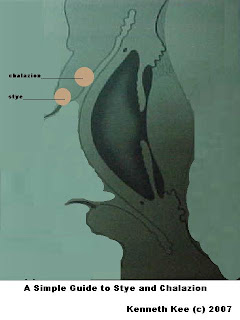
A Simple Guide to Stye & Chalazion
------------------------------------
What is a Stye?
----------------
A Stye is an infected gland at the edge of the eyelid.
How does a Stye develop?
-----------------------------
A stye develops when a gland supplying wax to eyelash at the edge of the eyelid becomes blocked and infected.
A stye can grow on the inside or outside of the eyelid.
Styes are not harmful to vision.
They can occur at any age.
What are the Symptoms and Signs of Stye?
--------------------------------------------------
A stye starts with pain, redness, tenderness and swelling in the area of the oil gland of the eyelid. Then a small pimple appears. Sometimes just the immediate area is swollen.
At other times the entire eyelid swells.
There may be frequent tearing in the affected eye, a feeling like something is in the eye or increased light sensitivity.
What Causes Styes?
-----------------------
Most Styes are caused by staphylococcal bacteria.
This bacterium is often found in the nose, and it's easily transferred to the eye by rubbing first your nose, then your eye.
Styes are not normally harmful to vision
They generally heal within a few days.
What is the Treatment for Stye?
--------------------------------------
Most styes heal within a few days on their own.
You can apply hot compresses for 10 to 15 minutes, three or four times a day over the course of several days. This will relieve the pain and bring the stye to a head, much like a pimple. The stye ruptures and drains, then heals.
If you have frequent styes, your eye doctor may prescribe a course of antibiotic and ask you to apply an antibiotic eye ointment to kill the bacteria causing the stye.
In most cases, the Styes formed inside the eyelid either disappear completely or rupture on their own. In some cases, the styes become bigger and can be more serious.
These styes may need to be surgically incised and drained by your eye care practitioner.
What is a Chalazion?
-------------------------
Chalazion is an another type of Eyelid swelling usually inner to the edge of the eyelid.
Often mistaken for a stye, a chalazion is an enlarged, blocked oil gland (tarsal gland)in the inner lining of the eyelid and not at the edge of the eyelid as in the case of a stye.
A chalazion may look like a stye for the first few days, then turns into a hard painless lump in the inner eyelid later on.
Most chalazion develops further from the eyelid edge than stye.
The same treatment is used for the healing of a chalazion.
However in this case, the swelling may linger for one to several months.
If the chalazion remains after several months, your eye doctor may surgically incise and drain it to facilitate healing.
------------------------------------
What is a Stye?
----------------
A Stye is an infected gland at the edge of the eyelid.
How does a Stye develop?
-----------------------------
A stye develops when a gland supplying wax to eyelash at the edge of the eyelid becomes blocked and infected.
A stye can grow on the inside or outside of the eyelid.
Styes are not harmful to vision.
They can occur at any age.
What are the Symptoms and Signs of Stye?
--------------------------------------------------
A stye starts with pain, redness, tenderness and swelling in the area of the oil gland of the eyelid. Then a small pimple appears. Sometimes just the immediate area is swollen.
At other times the entire eyelid swells.
There may be frequent tearing in the affected eye, a feeling like something is in the eye or increased light sensitivity.
What Causes Styes?
-----------------------
Most Styes are caused by staphylococcal bacteria.
This bacterium is often found in the nose, and it's easily transferred to the eye by rubbing first your nose, then your eye.
Styes are not normally harmful to vision
They generally heal within a few days.
What is the Treatment for Stye?
--------------------------------------
Most styes heal within a few days on their own.
You can apply hot compresses for 10 to 15 minutes, three or four times a day over the course of several days. This will relieve the pain and bring the stye to a head, much like a pimple. The stye ruptures and drains, then heals.
If you have frequent styes, your eye doctor may prescribe a course of antibiotic and ask you to apply an antibiotic eye ointment to kill the bacteria causing the stye.
In most cases, the Styes formed inside the eyelid either disappear completely or rupture on their own. In some cases, the styes become bigger and can be more serious.
These styes may need to be surgically incised and drained by your eye care practitioner.
What is a Chalazion?
-------------------------
Chalazion is an another type of Eyelid swelling usually inner to the edge of the eyelid.
Often mistaken for a stye, a chalazion is an enlarged, blocked oil gland (tarsal gland)in the inner lining of the eyelid and not at the edge of the eyelid as in the case of a stye.
A chalazion may look like a stye for the first few days, then turns into a hard painless lump in the inner eyelid later on.
Most chalazion develops further from the eyelid edge than stye.
The same treatment is used for the healing of a chalazion.
However in this case, the swelling may linger for one to several months.
If the chalazion remains after several months, your eye doctor may surgically incise and drain it to facilitate healing.




